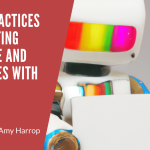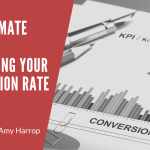 We love Etsy and we love using AI to streamline the creation of printable products. Given that AI tools and content creation are still relatively new, it should come as no surprise that the rules for selling AI-generated products on Etsy are constantly evolving.
We love Etsy and we love using AI to streamline the creation of printable products. Given that AI tools and content creation are still relatively new, it should come as no surprise that the rules for selling AI-generated products on Etsy are constantly evolving.
If you’re an Etsy seller, you must understand what those rules are and how they apply to you and your products. In this article, we’ll explain what the rules are now and provide some hints about where we think they might go in the future.
The Potentially Uncomfortable Intersection of Etsy and AI
 Etsy got its start as an online marketplace where users could open shops to sell handmade or resourced products. In the early days, examples included things like jewelry, apparel, accessories, original artwork, and thrifted and/or refurbished items.
Etsy got its start as an online marketplace where users could open shops to sell handmade or resourced products. In the early days, examples included things like jewelry, apparel, accessories, original artwork, and thrifted and/or refurbished items.
Over the years, particularly as the availability and demand for digital products has grown, they’ve expanded. Today, many Etsy sellers earn their money by designing and selling digital products. With the recent influx of AI tools, it’s not surprising that Etsy—the handmade site—has had to grapple with users implementing AI tools in product creation.
In 2024, Etsy laid out its guidelines for selling products created with the assistance of AI tools. As a seller, you’ll need to make sure you know the rules and what you need to do to adhere to them.
Can You Sell Products Created with AI on Etsy?
 You may be wondering if you can sell products you create using AI-powered tools on Etsy. The short answer is yes, you can.
You may be wondering if you can sell products you create using AI-powered tools on Etsy. The short answer is yes, you can.
Lots of Etsy shops contain products that were made or partially made with AI. This is what Etsy has said about its decision to allow sellers to list AI-created products in their shops.
After carefully considering the complex issues surrounding AI-generated content, we have decided to continue to allow sellers to use their original prompts in combination with AI tools to create the artwork they sell on Etsy.
Notice how carefully they’ve worded this statement. They’ve placed an emphasis on the use of “original prompts,” something that is clearly meant to serve as a rebuttal to those who have pushed for an AI ban. Etsy’s statement acknowledges that AI tools are only successful when someone knows how to write effective prompts to get the results they want.
What Are Your Responsibilities as a Seller?
Now let’s get into what you need to do as a seller. The second part of Etsy’s statement about selling AI-generated or AI-assisted products says this:
Sellers must disclose within their listing description if an item is created with the use of AI.
Etsy has chosen to leave it up to shoppers to decide whether they want to spend their money on products that were created with the use of AI.
 What we don’t entirely love about the disclosure process is the way it’s worded. When you click on the “Item Details” section of the Product Description, you’ll need to choose from one of four options.
What we don’t entirely love about the disclosure process is the way it’s worded. When you click on the “Item Details” section of the Product Description, you’ll need to choose from one of four options.
- Handpicked refers to vintage items that you have personally sourced and may also have refurbished.
- Sourced refers to items you have purchased, including things like party supplies and decorations.
- Handmade refers to any product you have made with your own hands and may include items created using tools such as a Cricut.
- Designed refers to any digital product created with AI.
We dislike the use of “Designed” as a category, mostly because it doesn’t allow for things like human-designed wall art. We hope that Etsy will eventually come up with a separate designation for AI. There’s been a significant amount of online chatter from Etsy sellers who are unhappy with some or all of Etsy’s decision about selling AI products.
Which AI Products Are Prohibited on Etsy?
Etsy has made another major announcement about AI, and that has to do with the sale of AI prompts. AI prompts are the words product creators use to generate written content or images with AI tools. If you remember, Etsy specifically called out the originality of prompts and seems to be drawing a line between creators who write their own prompts and those who don’t.
At the same time Etsy announced its guidelines for selling AI-created products, it also announced a complete ban on selling AI prompt bundles. As soon as the announcement was made, the company began removing products that violated the policy. In 2024, they said they removed twice as many products as they did in 2023.
Why Are People Opposed to Selling AI-Generated Products on Etsy?
 You might be wondering why there’s so much opposition to selling products created with AI on Etsy. We can’t say what’s in anybody else’s head, but we believe that a lot of it has to do with longtime Etsy sellers fearing that AI-created products will eat into their sales. They’re probably right to some degree.
You might be wondering why there’s so much opposition to selling products created with AI on Etsy. We can’t say what’s in anybody else’s head, but we believe that a lot of it has to do with longtime Etsy sellers fearing that AI-created products will eat into their sales. They’re probably right to some degree.
One of the big selling points of AI is that it can be used to create products very quickly, sometimes in less than a minute. Creating something with Canva’s drag-and-drop technology (before it added the Magic Studio AI tools) could take a lot of trial and error to create a template or product. The addition of AI means quicker product creation and, in a lot of cases, lower prices.
For people who have been handmaking products to sell on Etsy, it’s threatening to have millions of low-cost AI products competing with them. Etsy’s working hard to straddle the line, keeping their OG users happy while making room for those who use technology to create products.
Will Etsy’s AI Guidelines Change?
The answer to this question is certainly YES. AI technology is still in the early stages of existence and the technology is evolving every day. We can’t say what the future will hold and neither can Etsy. We’ll have to wait and see what happens, and you can be sure we’ll let you know if they update their guidelines.
Need some help creating Etsy success? Check out Easy Implementation: Etsy Success to get exactly what you need!



